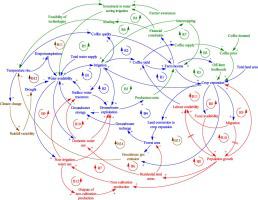Climate Risk Management ( IF 4.4 ) Pub Date : 2020-11-02 , DOI: 10.1016/j.crm.2020.100255 Yen Pham , Kathryn Reardon-Smith , Shahbaz Mushtaq , Ravinesh C. Deo

|
Drought is a major cause of crop failure and livelihood insecurity, affecting millions of people across the world. A changing climate, increasing population and economic growth are exacerbating water shortages, further interrupting agricultural production. Assessing and minimizing the impacts of drought require a thorough understanding of the interrelationships and interactions between the climate system, ecosystems and human systems. In this paper, we apply causal loop modelling grounded in systems thinking theory to examine the interdependencies and feedback processes among factors associated with drought that impact crop production using a case study of Robusta coffee production systems in Viet Nam – the world’s second-largest coffee producing country. Our model, underpinned by qualitative data from consultation with a range of stakeholders, indicates that water depletion affecting coffee cultivation is not solely attributed to rainfall insufficiency but an outcome of complex interactions between climate and socio-economic systems. Our analysis highlights that uncontrollable coffee expansion, largely at the expense of forested areas, is partly the unintended consequence of policy decisions, including those encouraging migration and perennial crop development. Growing water demand in the region, including the demand for irrigation water driven by the ever-increasing area under coffee cultivation, as well as inefficient irrigation practices are placing significant pressure on water resources. A changing climate may exacerbate the problem, further impacting coffee cultivation, unless adaptation practices occur. A number of potential interventions are suggested, including explicit zoning of coffee-growing areas; awareness raising for wide adoption of optimal irrigation practices; converting Robusta coffee monocultures to diversified systems; and strictly protecting existing forests coupled with afforestation and reforestation. These interventions should be simultaneously implemented in order to adequately address drought and water scarcity for coffee production and build resilience to climate and market risks.
中文翻译:

干旱影响的反馈模型:以越南咖啡生产系统为例
干旱是造成农作物歉收和生计不安全的主要原因,影响了全世界数百万人。气候变化,人口增加和经济增长加剧了水资源短缺,进一步中断了农业生产。评估和尽量减少干旱的影响,需要对气候系统,生态系统和人类系统之间的相互关系和相互作用有透彻的了解。在本文中,我们以世界上第二大咖啡生产国越南的罗布斯塔咖啡生产系统为例,应用基于系统思维理论的因果循环模型来研究与干旱影响作物生产的因素之间的相互依赖性和反馈过程。国家。我们的模型以与众多利益相关者进行协商后得到的定性数据为基础,指出影响咖啡种植的耗水不仅是由于降雨不足,而且是气候与社会经济系统之间复杂相互作用的结果。我们的分析突出表明,无法控制的咖啡扩张(很大程度上以森林地区为代价)在一定程度上是政策决策的意外结果,包括那些鼓励移民和多年生作物生长的决策。该地区不断增长的用水需求,包括咖啡种植面积不断增加带来的对灌溉用水的需求,以及低效的灌溉做法,给水资源带来了巨大压力。除非采取适应措施,否则气候变化可能会加剧问题,进一步影响咖啡种植。建议了许多潜在的干预措施,包括对咖啡种植区的明确分区;提高认识,广泛采用最佳灌溉做法;将罗布斯塔咖啡的单一种植转变为多元化的体系;严格保护现有森林,并进行植树造林。这些干预措施应同时实施,以充分解决咖啡生产中的干旱和缺水问题,并增强抵御气候和市场风险的能力。


























 京公网安备 11010802027423号
京公网安备 11010802027423号